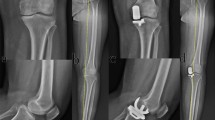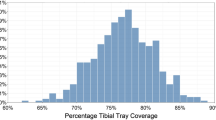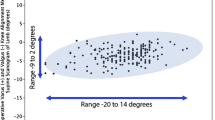Abstract
Purpose
Eight patients treated with kinematically-aligned (KA) total knee arthroplasty (TKA) presented with tibial component failure. We determined whether radiographic measurements and clinical characteristics are different between patients with and without tibial component failure to identify mechanisms of failure and strategies to reduce the risk.
Methods
Out of 3,212 primary TKAs (2,725 TKAs with a two-year minimum follow up), of which all were performed with KA, eight patients presented with tibial component failure. Radiographic measurements, clinical characteristics (e.g. age, gender, BMI, etc.), revision surgical records, and Oxford knee scores were compared to control cohort patients matched 1:3.
Results
Tibial component failure presented at an average of 28 ± 15 months after primary TKA. Patients with tibial component failure had a 6 kg/m2 greater body mass index (p = 0.034) and 5° greater posterior slope of the tibia component (p = 0.002) than controls. Final follow-up averaged 56 ± 19 months after the primary TKA and 28 ± 24 months after the revision TKA. The final Oxford knee score was 39 ± 4.6 for patients with tibial component failure and 44 ± 6.5 for the controls (p = 0.005).
Conclusions
The incidence of tibial component failure after KA TKA was 0.3% and was caused by posterior subsidence or posterior edge wear and not varus subsidence. The strategy for lowering the risk of tibial component failure when performing KA is to set the tibial component parallel to the flexion-extension plane (slope) and varus-valgus plane of the native joint line.




Similar content being viewed by others
References
Abdel MP, Bonadurer GF 3rd, Jennings MT, Hanssen AD (2015) Increased aseptic tibial failures in patients with a BMI ≥35 and well-aligned total knee arthroplasties. J Arthroplast 30(12):2181–2184. doi:10.1016/j.arth.2015.06.057
Berend ME, Ritter MA, Meding JB, Faris PM, Keating EM, Redelman R, Faris GW, Davis KE (2004) Tibial component failure mechanisms in total knee arthroplasty. Clinical Orthop Rel Res (428):26–34
Gunst S, Fessy MH (2015) The effect of obesity on mechanical failure after total knee arthroplasty. Ann Transl Med 3(20):310. doi:10.3978/j.issn.2305-5839.2015.10.37
Ritter MA, Davis KE, Meding JB, Pierson JL, Berend ME, Malinzak RA (2011) The effect of alignment and BMI on failure of total knee replacement. J Bone Joint Surg Am 93(17):1588–1596. doi:10.2106/JBJS.J.00772
Calliess T, Bauer K, Stukenborg-Colsman C, Windhagen H, Budde S, Ettinger M (2016) PSI kinematic versus non-PSI mechanical alignment in total knee arthroplasty: a prospective, randomized study. Knee Surg Sports Traumatol Arthrosc. doi:10.1007/s00167-016-4136-8
Waterson HB, Clement ND, Eyres KS, Mandalia VI, Toms AD (2016) The early outcome of kinematic versus mechanical alignment in total knee arthroplasty: a prospective randomised control trial. Bone Joint J 98-B(10):1360–1368. doi:10.1302/0301-620X.98B10.36862
Dossett HG, Estrada NA, Swartz GJ, LeFevre GW, Kwasman BG (2014) A randomised controlled trial of kinematically and mechanically aligned total knee replacements: two-year clinical results. Bone Joint J 96-B(7):907–913. doi:10.1302/0301-620X.96B7.32812
Nam D, Nunley RM, Barrack RL (2014) Patient dissatisfaction following total knee replacement: a growing concern? Bone Joint J 96-B(11 Supple A):96–100. doi:10.1302/0301-620X.96B11.34152
Young SW, Walker ML, Bayan A, Briant-Evans T, Pavlou P, Farrington B (2017) The Chitranjan S. Ranawat Award: no difference in 2-year functional outcomes using kinematic versus mechanical alignment in TKA: a randomized controlled clinical trial. Clin Orthop Relat Res 475(1):9–20. doi:10.1007/s11999-016-4844-x
Howell SM, Hull ML (2016) Kinematic alignment in total knee arthroplasty. In: Scott S (ed) Insall and Scott surgery of the knee. 5th edn. Elsevier, Philadelphia
Howell SM, Papadopoulos S, Kuznik KT, Hull ML (2013) Accurate alignment and high function after kinematically aligned TKA performed with generic instruments. Knee Surg Sports Traumatol Arthrosc 21(10):2271–2280. doi:10.1007/s00167-013-2621-x
Howell SM, Howell SJ, Kuznik KT, Cohen J, Hull ML (2013) Does a kinematically aligned total knee arthroplasty restore function without failure regardless of alignment category? Clin Orthop Relat Res 471(3):1000–1007. doi:10.1007/s11999-012-2613-z
Howell SM, Papadopoulos S, Kuznik K, Ghaly LR, Hull ML (2015) Does varus alignment adversely affect implant survival and function six years after kinematically aligned total knee arthroplasty? Int Orthop 39(11):2117–2124. doi:10.1007/s00264-015-2743-5
Klatt BA, Goyal N, Austin MS, Hozack WJ (2008) Custom-fit total knee arthroplasty (OtisKnee) results in malalignment. J Arthroplast 23(1):26–29. doi:10.1016/j.arth.2007.10.001
Oussedik S, Abdel MP, Cross MB, Haddad FS (2015) Alignment and fixation in total knee arthroplasty: changing paradigms. Bone Joint J 97-B(10 Suppl A):16–19. doi:10.1302/0301-620X.97B10.36499
Dossett HG, Swartz GJ, Estrada NA, LeFevre GW, Kwasman BG (2012) Kinematically versus mechanically aligned total knee arthroplasty. Orthopedics 35(2):e160–e169. doi:10.3928/01477447-20120123-04
Nedopil AJ, Howell SM, Rudert M, Roth J, Hull ML (2013) How frequent is rotational mismatch within 0 degrees ±10 degrees in kinematically aligned total knee arthroplasty? Orthopedics 36(12):e1515–e1520
Nedopil AJ, Howell SM, Hull ML (2016) Does malrotation of the tibial and femoral components compromise function in kinematically aligned total knee arthroplasty? Orthop Clin North Am 47(1):41–50. doi:10.1016/j.ocl.2015.08.006
Roth JD, Howell SM, Hull ML (2015) Native knee laxities at 0 degrees, 45 degrees, and 90 degrees of flexion and their relationship to the goal of the gap-balancing alignment method of total knee arthroplasty. J Bone Joint Surg Am 97(20):1678–1684. doi:10.2106/JBJS.N.01256
Howell SM, Kuznik K, Hull ML, Siston RA (2010) Longitudinal shapes of the tibia and femur are unrelated and variable. Clin Orthop Relat Res 468(4):1142–1148. doi:10.1007/s11999-009-0984-6
Nedopil AJ, Howell SM, Hull ML (2017) What clinical characteristics and radiographic parameters are associated with patellofemoral instability after kinematically aligned total knee arthroplasty? Int Orthop 41(2):283–291. doi:10.1007/s00264-016-3287-z
Indrayan A (2013) Methods of clinical epidemiology. In: SARDaGMW (ed) Springer Series on Epidemiology and Public Health. Springer-Verlag Berlin Heidelberg, p 24. doi:10.1007/978-3-642-37131-8_2
Feldman DS, Henderson ER, Levine HB, Schrank PL, Koval KJ, Patel RJ, Spencer DB, Sala DA, Egol KA (2007) Interobserver and intraobserver reliability in lower-limb deformity correction measurements. J Pediatr Orthop 27(2):204–208. doi:10.1097/01.bpb.0000242441.96434.6f
Gu Y, Roth JD, Howell SM, Hull ML (2014) How frequently do four methods for mechanically aligning a Total knee arthroplasty cause collateral ligament imbalance and change alignment from normal in white patients? J Bone Joint Surg Am 96(12):e101
Acknowledgements
We wish to thank Robert Harper, MD for making the radiographic measurements used to compute the intraclass correlation coefficients.
Author information
Authors and Affiliations
Corresponding author
Ethics declarations
The authors have not received grant support or research funding and do not have any proprietary interests in the materials described in the article.
Conflict of interest
The authors declare no competing interests.
Funding
There is no funding source.
Ethical approval
An institutional review board approved this study (IRB 813565–1). For this type of study formal consent is not required.
Rights and permissions
About this article
Cite this article
Nedopil, A.J., Howell, S.M. & Hull, M.L. What mechanisms are associated with tibial component failure after kinematically-aligned total knee arthroplasty?. International Orthopaedics (SICOT) 41, 1561–1569 (2017). https://doi.org/10.1007/s00264-017-3490-6
Received:
Accepted:
Published:
Issue Date:
DOI: https://doi.org/10.1007/s00264-017-3490-6




